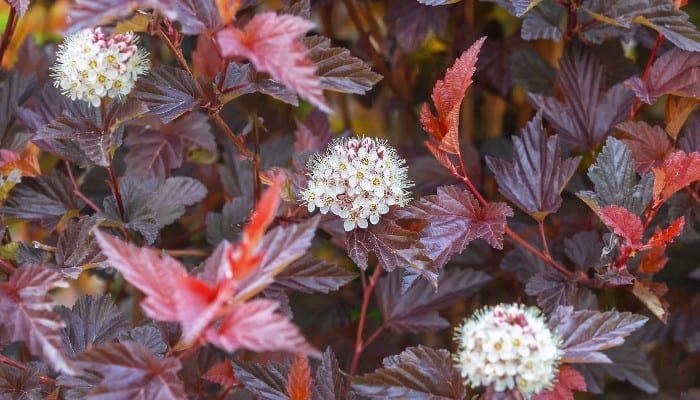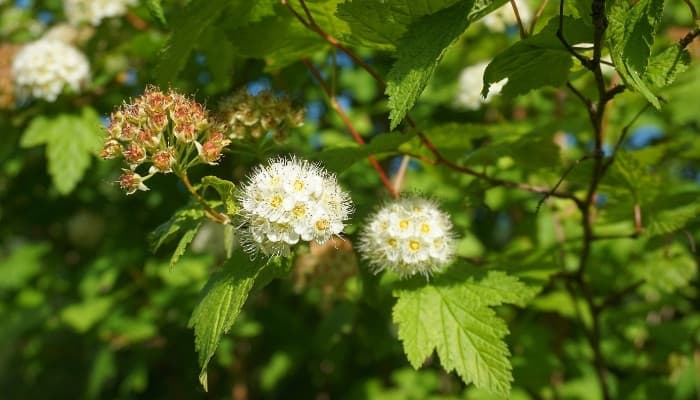Deer can be problematic, as they may cause damage to your property or garden in certain situations.
That’s why many people choose to plant deer resistant plants to discourage deer from coming onto the property in the first place.
Is ninebark deer resistant? In some areas, deer avoid ninebark, particularly established plants. In other areas, deer will eat it, especially when plants are young and tender. Ninebark is not considered to be completely resistant to deer, but it does not rank high as a favorite of deer and will usually survive light grazing.
Given the choice between ninebark and Japanese barberry, which is similar in appearance, barberry is better at repelling deer.
Both plants share similar ornamental properties, but ninebark is considered more appealing and is noninvasive. Some people find that it is effective at repelling deer while others claim that deer enjoy eating it.
Best Deer-Resistant Ninebark Varieties
If you can’t get Japanese barberry to grow but would like a similar plant, ninebark makes an excellent alternative.
Even though it’s not completely deer resistant, most deer will merely browse the ninebark and depart without eating or damaging your plants.
However, there are several kinds of ninebark, and it’s important to find the best ninebark for your area if you want to promote its growth.
Common Ninebark

Common ninebark is the most prevalent type of ninebark, and like related species, it is not completely deer resistant.
While your deer might graze lightly on ninebark, they are unlikely to totally destroy it.
You can identify common ninebark by its white or pink flowers when in bloom. People recognize it from the peeling bark, which has reddish bark underneath the surface.
During the summer, blooms and leaf foliage tend to hide the bark, though a nosing deer might still find it.
Ninebark grows upright, tolerates drought, and enjoys full sun. It’s a hardy plant and can survive in shaded areas.
Pacific Ninebark

Pacific ninebark has reddish bark that strips away to reveal more layers. It grows to approximately 12 feet tall and has lobed leaves similar to a maple tree.
Unlike common ninebark, the Pacific variant grows along streams and wetlands.
It has small white flowers and bright red berries that encourage birds and other wildlife.
It has green leaves rather than the purplish-yellow leaves of some ninebarks and does well as a background shrub or in wild gardens.
Mallow Ninebark
Mallow ninebark has a distinctive vase shape and leaves similar to grape or currant leaves. In fall, the leaves vary from red to brown. Average height is between 3 and 6 feet.
Mountain or Low River Ninebark
Mountain ninebark is prevalent in the western United States. It has spirea-type white flowers and bark that ranges from cinnamon to tan, depending on how many layers peel off.
Like other ninebarks, it attracts some wildlife, especially butterflies and bees, and makes an excellent garden border.
Ninebark Care Guide
How you care for ninebark depends partly on the ninebark type, but some things are consistent for all ninebark varieties.
Planting Ninebark
Different ninebark varieties prefer different habitats. For instance, Pacific ninebark occurs in Alaska, Santa Barbara, and British Columbia.
However, it doesn’t venture much past Alberta and prefers wetlands and lower altitudes.
Ninebarks thrive in rocky soils and prefer acidic or neutral soil pH levels to basic.
Because they sometimes grow beside streams naturally, mulch is often recommended to trap moisture and promote growth in ninebarks.
When planting ninebark, you need to dig a hole that is big enough for growth while still keeping the roots near the surface.
Most gardeners recommend digging a hole twice the size of the pot your ninebark shrub came in.
Once dug, ensure the roots sit close to the surface, and pack the hole with dirt, ensuring there are no air pockets.
Watering & Fertilizing Ninebark
Established ninebark not only discourages deer but requires minimal watering. It can thrive in droughts, so a soil with low moisture isn’t a problem.
However, when first planting ninebark, it’s better to water it regularly. If necessary, it can also flourish in over-watered soil and contend with floods.
In addition to minimal water needs, ninebarks do well with fertilizer. Spring is the best time for applying fertilizer, and experts recommend compost or organic plant foods geared towards shrubs.
When fertilizing, start a few inches away from the ninebark’s trunk, and spread it evenly until you reach the point where the branches end.
How To Prune Ninebark
Ninebark flowers in late spring and early summer. It’s at its best between June and July, though some varieties blossom as early as May.
When pruning ninebark, don’t put it off later than mid-August. If you’re pruning newer ninebark, emphasize maintaining its shape and increasing air flow by cutting away old or dead branches.
If you have an older, more established ninebark, you can drastically cut it back. With these older ninebarks, pruning closer to the ground level helps them regenerate during the winter.
Don’t hesitate when pruning. Ninebarks are tenacious, which is one of the reasons they stand up well to deer browsing.
They recover quickly from pruning and are often better for it.
Related Questions:
While ninebark isn’t necessarily deer resistant, you may still have other questions about this hardy border shrub. Here are some of the most common.
What Is Eating My Ninebark?
Ninebark provides food for:
- Bees.
- Butterflies.
- Wasps.
- Aphids.
Its berries are also a food source for various game birds. Deer might nibble ninebark but are unlikely to eat it to the ground.
What To Plant With Ninebark?
Since ninebark makes an excellent border, chances are you want to plant it with something else.
Many people grow ninebark with spirea, which is a relative of the ninebark shrub. Depending on the ninebark type, phlox can also be popular.
Since ninebark is a medium-sized shrub, another option is to grow it alongside other shrubs of similar size, like lilac.
Alternatively, ninebark’s leaves can be used to contrast other perennials like bee balm and coneflowers.
Conclusion
Ninebark is not entirely deer resistant, but it is not a favorite of deer either. It’s a low-maintenance deciduous shrub that won’t take over your garden.
It is especially popular as a border plant in gardens because it comes in several types can be grown alongside a variety of other flowers.
Considering the fact that ninebark commonly survives in areas with a large deer population, it may be worthwhile to plant one or two to see how they do.

![Is Ninebark Deer Resistant? [+ Best Varieties & Care Guide]](https://whyfarmit.com/wp-content/uploads/2021/12/Ninebark-shrub-in-bloom.jpg)